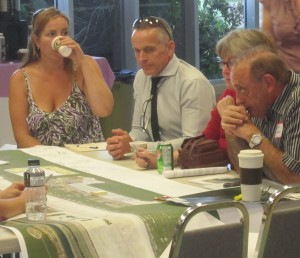 By Pepper Parr
By Pepper Parr
December 16, 2014
BURLINGTON, ON.
City Council met for the first time as a Standing Committee since they were all re-elected.
One of the first tasks they complete is selecting the chairs and vice chairs of the four Standing Committees.
Last night Paul Sharman was chosen as chair of the Development and Infrastructure Committee with Blair Lancaster as the vice chair.
The Committee of the Whole will have Councillor Craven as the vice chair and Councillor Jack Dennison as the Chair. Craven said he would accept the vice chair of the COW with some conditions. He wanted there to be a half day workshop for Council members on the use of the Procedural bylaw and how Standing Committees should be run.
Craven, who understand the Procedural bylaw better than anyone else on Council and has used it to his advantage on more than one occasion, want to see more discipline on how Standing Committees are run. He also wants Council members to deal with their own wards and not butt into what takes place in other wards.
Councilor Meed Ward sees her self as a Councillor for the city with specific responsibilities in ward 2. Easy to see why those two don’t get along.
Expect some very messy debate on this issue. Councillors Craven and Meed Ward don’t get along all that well personally and each has a decidedly different view as to what a Council member should do.
Meed Ward tends to run her ward with a very wide open approach – Councillor Craven is more comfortable with everything buttoned down and under control.

Ward 5 Councillor Paul Sharman can be smooth as silk and tough as nails – he chooses which he wants to be to suit his purpose. The original bluster we saw during his first year in office has moderated a bit.
In 2011 Sharman was exceptionally vocal on the budget that was passed that year. With a number of important development applications coming before Council we can expect Sharman to voice some strong opinions.
This Council is very frustrated over what they feel they are not able to do with development applications that get presented to the Planning department.
A meeting in November on the application to build two towers on Pinedale in the Appleby Mall on New Street drew 300 people who were very unhappy at this kind of development in their community. Sharman said both he and many of his colleagues were frustrated about the procedure they had to live with.
There are several issues at play here. The province has said Burlington must grow. Councillor Craven pointed out that with the urban boundary ending at Dundas – the growth can only happen with intensification. That’s the price we have to pay said Craven if we want to keep that rural part of the city.
Councillor Meed Ward told her fellow council members that “people want to be part of the vision casting” which she added could be very exciting. Right now she said Council is battling the one offs that get brought to the Council Chamber. “Community should be at the centre of what we are doing – Council are the enablers”, John Taylor broke into one of his mile wide smiles and said he supported Meed Ward’s thinking “whole heartedly”.
The biggest issue he heard at the door during the election, said Taylor, was intensification. “They don’t understand it and they fear it.”
The province has said Burlington must grow. The projection is for the city to grow to 220,000 people between 2031 and 20141 with an additional 55,000 people shortly after that.

Councillor Meed Ward wants the public deeply involved in creating the vision for the city. Councillor Taylor supports that view. No clear yet where the Mayor stands on this – he does want the public to fully understand what intensification will mean to the city.
Mayor Goldring said “we have to engage the public in this issue”. He put forward a Staff Direction “… for a “fully defined and integrated communications program to provide community engagement, dialogue and participation with Burlington residents as to how and why we will transition development in urban areas of the community.”
Expect some heavy debate on this one as well. Council doesn’t yet have a cohesive vision and they are far from agreement as to how they should go about working with the public to create one.
With neither a vision or a clear understanding and deeply rooted commitment to engaging the community, Burlington has four interesting years ahead.




















Can’t we dispense with the Orwellian term “intensification” and call it what it really is, “overcrowding”.
The Mayor seem to have forgotten about the strategic plan – issuing a direction – community engagement, dialogue and participation with Burlington residents as to how and why we will transition development in urban areas. This is already stated – issuing another direction is like issuing a dinner menu while the Titanic sinks. The Mayor by reissuing a direction either does not remember the strategic plan or is publically telling us what we already know – a majority – not all see public comment and engagement as a 2nd thought or more or a bother – multiple times the city fails on communication. As for Councillor Sharman – me thinks his opinion woudl be different if this the towers were being built next to his house. He has lived here for just over his 1 term on council – he is on the record for telling people to move or if they did not like it go to the OMB. It is my humble opinion we can grow the city but the developers need to be controlled and unsure if the present staff and leadership are up to the challenge
“Councillor Meed Ward told her fellow council members that “people want to be part of the vision casting” which she added could be very exciting”.
Sounds like a huge waste of time and money. Words like ‘vision casting’ mean exactly what? Coming from a person who has led what exactly? Leading people that have most likely nil to zero experience in urban planning. And the ability to articulate what they want? You only know what you want once you live it.
The people of Burlington are status quo. No high rises. No intensification. No bike lanes. No races on Lakeshore. No lake access. And they are being led by people who can’t or won’t execute a City strategic plan for fear of alienating the voters. Council was elected to lead. Hard to see them doing that if the next 4 years are like the last 4 years.
Start with 3 visions provided by urban planners. See which vision people gravitate to. Then refine through public consultation.
Good luck with the cat herding.
All good and all true but we get the government and bureaucracy that we deserve. When 66% of the eligible electorate can’t find the time to vote, despite online voting and advanced polls, what does that say about the general engagement of Burlington citizens. We’ll get the same tired approaches and staff indifference until we care enough to force a change in attitudes and approaches.
What you say is true, and is an old saw. But what do we do, wait for the next election, which won’t be any different?
I’m not sure what to do, but at least 34% found the time to vote, and 300 turned up for the Appleby twin towers proposal, and you don’t need everyone to get change, so don’t quit.
Only losers quit!
For most residents of Burlington intensification is not the issue..It is the OVER INTENSIFICATION that is unpalatable.
I agree it is over-intensification that’s the problem, but also the impression citizens are given, or have, that they can’t do anything about it. It seems that it isn’t really our city or neighborhood to have any say in how it will be changed.
The OP and the bylaws are not seen as necessarily binding, but somehow “guiding”, and so can be treated like putty. The OMB appeal tactic by developers and their shills is always there, and these can be costly. It’s like a casino and the city is a real estate play.
The planning justification reports for the sky is the limit applications are all very general, mostly qualitative, very similar over applications, and always support the application (of course, that’s what they are paid for) and conclude they represent “good planning”. Another planner can have the opposite opinion, This is the planners dilemma, especially for the city planners. In a way, I feel sorry for them.
The citizens have almost no real say as they are not recognized by the process as “experts”. They can go to the statutory public meeting, to express their views, where they too can soon find themselves hung up on the horns of the planners dilemma.
There is usually no quantification in support of the justification. That is, how does the developer and planning consultant arrive at the conclusion that the unit height, yield, and density proposed meet with the policy framework, the OP, and are justified as “good planning”? Where is the objective data to support the opinion? Again, the planners dilemma.
The need for an overall vision for the various parts of the city is acute, as we are caught in a piecemeal, one proposal at a time process of decision-making. There is no context that I know of, although the OP and bylaws are supposed to provide that context with more or less guidance on limits with some process for variances that still fit the overall intent of the OP. I think something is going on for a Plains Rd planning vision, but it has been more than a year since I saw anything on this.
But these don’t seem to be really respected by developers, and more so now, may be just ignored and flaunted with audacious proposals. It is often reactive and acrimonious, as we well know, and it appears that this is only going to get worse.
It is just the start of a new term of Council, and how intensification can be controlled to put the people and jobs in places they belong and can be rationalized should be a kick-off priority. And I mean the city needs to count how many people and jobs, in balance with Places to Grow targets, and emphasis on both of them, are being or could be accommodated, and where they best fit. There need to be triggers in place that function to keep some semblance of balance between people and jobs in place.
There are far too many development proposals put forward that are basically for residential, contributing almost exclusively to the people count. These are far easier to sell and offer the most profit. Developers run to get their lands rezoned to residential.
This needs to change, by massaging the system to force the eventual developments to move to a balance. I’m saying that the Places to Grow intensification targets cannot be used just to promote and justify sky high residential towers to meet the people counts, but at the same time basically ignore that there are coupled employment or job targets that are also in the Places to Grow plan. This balancing needs to be a city priority to develop, and some form of macro constraint system needs to be implemented. The city needs to get on with collecting and publishing this kind of data.
The Mixed Use designation is abused with very little relative space allotted for retail, but this doesn’t come anywhere near meeting the jobs part of the Places to Grow targets. On initial thought, I could be more likely to support a proposal for much more than the OP allows if there were several stories designed for office or similar uses that are job dense. Downtown, Mobility Centres, and Plains Rd are locations that come to mind for such real mixed use. Some say that the jobs will come “in the long term”, but as economics says, “in the long run, we are all dead.” We can’t wait!
Of course, all this requires political will to develop and implement. It will take away the individual Councillor’s exclusive power and influence. It will intrude on the powers and influences of staff in positions of influence. It will require unseen and unheard of levels of transparency, accountability, engagement, and information sharing. I’m not sure this will exists. I don’t see it in Ward 1.
One thing for sure, Council has to take charge of this or it will take charge of them, and us too.
I agree with all you said Tom.
The only thing I would add is that when “retail” is added. It does not have commercial venting, transport truck access, parking and is generally of such poor quality it’s not really “commercial space” – It’s just a scam.
I’ve been yelling about this problem for years now on Plains Road. The city just keeps cheerleading crap development after crap development. The newly approved “Jazz” condos have the same scam again.
We agree on the tiny retail being proposed as a token “Mixed Use” is a scam, to cover for the overwhelming dominance of the residential use. Thanks for the heads up on the facility quality and provision information. This means the space has a very low commercial value-added potential. How many nail salons (that like cash, no tax), hair salons, dental clinics, second hand clothing stores, and so on, do we need till saturation?
To my eye, they look basically like residential garages. At public meetings I have heard similar talk about the lack of broader use utility of these spaces.
I too have made comments to the city planners about this happening along Plains Road, and elsewhere more recently. Many of the new retail spaces are still totally empty, and older ones too are vacant. They just keep piling up though, as it seems that for the planning purpose they are like a hall pass.
As you said, the Jazz development continues the scam. I looked at the website and saw that the condos are selling at around $400 a square foot, to buy a paper floor plan.
I am left wondering, if you design the retail element to facilitate “commercial venting, transport truck access and parking”, have you not greatly devalued any potential that the site has for residential use?
The sites are ideal for local retail and services (like nail salons and dental clinics). They are however not ideal for mass market (niche retailers that serve the wider area or big-boxes / chains). Many of these local uses need a greater density of local customers to make them economically viable – so it’s a bit of a chicken and egg problem. There are some great examples of high-quality urban retail developments (Metro’s store on Front St in Toronto is one of the best such developments in Canada), but these are far more expensive than they typical single story storage shed approach that the commercial developers typically build in suburban areas. Are they viable in a city like Burlington? Probably not when they have to compete with other retailers that have the traditional retail zoning, but in spots with very good transit and pedestrian connections (i.e. Paradigm) they could be very important.
A huge opportunity was missed in the Appleby Mall redesign, and now they’re faced with building tall towers to add a residential component on the site that will support the long-term upkeep of the property. Wal-Mart on Fairview also missed the boat if we held them to the kind of quality mixed use needed near our main transit hub.
It is tough for small businesses to compete against the chains who are able to pass off the external costs of the negative-value land uses onto the community. Parking lots are important to many retailers, but they impose a cost on their neighbours – devaluing their properties, as people don’t like spending top dollar to live near wide expanses of empty asphalt and truck & car traffic moving in and out. And single-use zoning is largely what led us to the mess we’re in with traffic and sprawl north of the QEW. More of the same isn’t the answer either.
Forget “vision” at this point I’d just take some REAL community process that affects things.
I’ve not gotten the impression that the staff is very interested in or reactive to public input. At meetings they seem more interested on keeping a lid on things and “respecting” the developer. There are lots of “meetings” where the staff explain something – people make comments – the same exact plan is shown again at a later meeting. The city seems to have the general tone that it’s all hopeless – you can’t stop these developers – you can’t control traffic – etc. The city is “locked” into the idea of transforming transportation as some sort of saviour – with zero idea of how to do that except for badgering people. It’s just not going to work. The place is going to get over developed, have massive traffic problems and then get run down – exactly like down town Hamilton.
The vision has to be an amenity rich community with shop, restaurants, cafes, parks, etc spread out and close to where people live. You need high quality commercial space for this – everywhere, reasonable commercial rates and an acceptance that 80% of people are coming by car no matter what you do.
That’s exactly the issue. If you “accept” that 80% (more like 90%) of the people are going to travel by car, you therefore have to have all of the road capacity and parking space that those cars require, which leaves a great deal less space for people, makes it less desirable to do anything different, requires a huge amount of tax dollars to maintain, and saddles people with tremendous costs that they have to pay just to be able to function in the city.
Downtown Hamilton destroyed itself by catering to the car first (timed lights, one-way arteries through the city) which led to the downtown becoming inhospitable for all but the most desperate.
I agree we need to do more than “badger” people to use transportation alternatives, firstly how about actually deciding to invest in them, and ensuring that transit, walking and cycling are a positive, enjoyable experience for citizens instead of a slow, risk-filled and third-class experience.
There are cities all over the world that have worse weather, are more spread out, and overcome whatever other excuses you can come up with, that have shown success in improving the mode share of non-car modes of transportation. It is not rocket science. We can change just as others have – both in Canada and around the world. But we have to be willing to start.
I’m for active transportation because you might get 5% of people walking. I’m for spending on transit because you might get 10% of people to use public transportation. Beyond 15% diversion you are expecting greater diversion than places in Europe have. These places have subways, covered transit stations, massive train systems, walking only areas, massive public sector spending, etc, etc, etc … and still have 85% of trips in cars.
You are not taking about “designing” areas from scratch. You are trying to retro fit areas with no money. I get the theory that if you transform all of Burlington in to an 8 hour a day traffic jam you can “force” people into an other mode of transit.
There is a reason the word “slum” exists – it’s easy to start – hard to stop. Just take your focus off what people want and start imposing your pet ideas on them. People with money and options will just leave.
Greg…it’s not as if the cities that have seen singificant share diverted to active transportation and transit were created from scratch either. It took time and determined planning to get there. Look at Copenhagen…in the 70’s they had bicycle mode share of 10%. They have now achieved 40% bicycle mode share, and haven’t rested on their laurels – they are aiming for 50%. Just one example. Of course you can make all kinds of excuses for why it won’t work in Burlington but ultimately there’s no reason why we can’t learn from them and many others.
It’s not as if we don’t have the money – we taxpayers pay a great deal of money to live here, and a sizable chunk of our tax bills goes to pay for road maintenance and construction. We have $300 million in the City’s capital budget over the next 10 years going towards roads. Over $2.5 billion at the Regional level over the next 10 years into roads.
Even with all that spending, we are falling behind on the maintenance on the roads we have now. And people are expecting somehow that more will solve the problem? More/wider roads just means more car trips due to the principle of induced demand. So we end up not solving the gridlock issues at all, we just increase the burden on the taxpayer to keep all those roads in acceptable condition. The status quo is not sustainable. Some of us will have to change. Better that we do what we can to encourage those of us who want to change, than to have it forced upon people and provide them with no viable alternatives.
When you have limited resources you have to maximize the efficiency of those resources. The single-occupant automobile is the least efficient user of that resource. Catering to that segment above all others (even if they are currently in the majority) is not good planning.
And you’re absolutely right, people with money and options will leave. For the most part they are choosing communities which are walkable, bikeable and have efficient transit. Burlington has a lot going for it in this regard, but the competition is getting better while we have been relatively stagnant. Increasingly, the people who are starting businesses and growing families do not want to build a life around an hours long car commute. It’s abundantly clear when you look at the market for housing in any major North American city.
If we continue to put the car first in our planning efforts, we will in time see much of the city become the ‘slum’ you described. I certainly don’t want that to happen.
Again I am a supporter of active transit, public transit and building complete communities. But I am not in support of pie in the sky “dream planning.” Copenhagen has virtually everyone living in a 10km box. We will at best have people living in a 50km box, plus stuffing people in Guelph/Waterloo and hundreds of thousands of people in Milton for some reason. Halton alone is 7 times larger than down town Paris.
It seems that Burlington / Halton will function like the out skirts of any major european city instead of a core. People will have family, friends, jobs, responsibilities, etc all over the place. 50% cycling in this area is delusional – the distances are too vast.
I applaud you passion for cycling, but realize you have elected yourself king. You have decided that we have “limited resources” – you have decided the “best way” for people to live. Now you intend to impose it on people. You intend to turn car travel into a nightmare and force people to live as you wish – for a good you perceive.
Well some people might perceive a good in going with there kids to a soccer game, visiting their mother, going out for dinner or spending time with their wife. No one is diving long distances because they love it so much, they have been forced into it by circumstance. Clogging the roads with over development will not change those circumstances. It will just turn the area into a vast Las Angeles with people wasting endless hours in gridlock.
Greg…you completely mistake my intentions here. It isn’t me that has decided that we have limited resources. That’s the reality we are faced with, unless you’re up for massive tax increases. I’m not forcing anything…I’m asking that we give people an honest choice as to how they get around (vs. the status quo which you have acknowledged forces people to choose to drive for most trips).
How does helping people to use other means of travel make car travel for the rest of the drivers in the city a nightmare? I realize that some people go into convulsions at the very sight of a bicycle or a bus, but I’d expect that having those cars no longer on the roads would have the opposite effect for drivers.
And yes, it’s obvious that achieving what a much denser city has done with a 40 year head start is not a realistic goal in our lifetimes). But that doesn’t mean that we have to dismiss their example altogether. It does demonstrate that there is a large amount of latent demand from people who WANT to ride their bikes (and don’t have to be forced to do so). They will do so more often if it is comfortable, safe and efficient. Over 30% of Ontario residents are bicycle riders.
Maybe we shoot for 5% in the next 10 years – that alone would mean we could handle about half of the growth that’s coming to Burlington in that timeframe without adding a single lane of new roadway. That would save twice the cost of the entire Cycling Master Plan, which we could put towards fixing our existing infrastructure. And that’s just in the first 10 years.
How did LA get the way it did? It built freeways everywhere, which created the expectation that motoring is easy and free. Yet those freeways eventually filled up as people and jobs sprawled outwards. In response, they built more roads and those filled up too. Only once it came to a crisis did they realize that continuing down that path was going to lead to ruin. Only recently LA has made active transportation and mass transit a priority. It would seem that you are in favour of continuing to make the same mistakes they made.
I don’t accept that “intensification” is somehow automatically a good thing, because it creates new problems. The province isn’t exactly a model of excellence to be emulated. Let’s be careful and avoid turning Burlington into another Mississauga.
Get used to change Mr. Jacobs. It’s not stopping. It can be shaped however.
Case in point, Mississauga has outgrown the sprawl classification. It is a very progressive city, worthy of many accolades.
– Strong growth both economically (attracting new business to impact their revenue) and population wise.
– Total population of approximately 824,000 by 2031 and 907,000 by
2051;
– total employment will grow to 525,000 by 2031 and 582,000 by 2051
– Their mass transit works well (express lanes for buses).
– Active transportation friendly (bike lanes cris-cross the City, including a bike ride, sponsored by the City and many corporate donors, that explores the City, attracting thousands of young and old riders every fall).
– Multiple large sprawling parks with water access (including amazing trout and salmon fishing, and Rattray Marsh, an amazing wildlife oasis)
How well does Burlington compare on those 4 items? Not well.
City Hall lacks leadership. No communication on a vision. No communication on how intensification will impact the quality of life (pro or con). They need to frame the discussion. Not being done.
Thanks for keeping an eye out for those of us that cannot or are not motivated enough to watch the machinations of council.
Intensification is a thorny issue and brings out the NIMBY’s in droves. However with good public engagement it can become less painful.